
Anemonoides nemorosa, the wood anemone, is an early-spring flowering plant in the buttercup family Ranunculaceae, native to Europe. Other common names include windflower, European thimbleweed, and smell fox, an allusion to the musky smell of the leaves. It is a perennial herbaceous plant growing 5–15 cm (2–6 in) tall.

Lilium bulbiferum, common names orange lily, fire lily,Jimmy's Bane,tiger lily and St. John's Lily, is a herbaceous European lily with underground bulbs, belonging to the Liliaceae.

Salvia glutinosa, the glutinous sage, sticky sage, Jupiter's sage, or Jupiter's distaff, is a herbaceous perennial plant belonging to the family Lamiaceae.

Inula is a genus of about 80 species of flowering plants in the family Asteraceae, native to Europe, Asia and Africa.
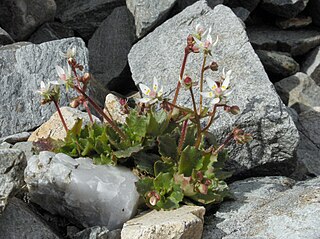
Micranthes stellaris, synonym Saxifraga stellaris, the starry saxifrage or hairy kidney-wort, is an Arctic–alpine species in the family Saxifragaceae. It produces panicles of 5–10 white flowers on a stem up to 20 cm (7.9 in) tall, rising from a basal leaf rosette. One subspecies is found from eastern Canada to Russia, including the British Isles, while another is found in the mountains of southern Europe.
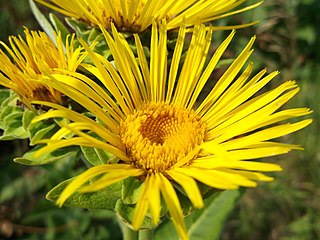
Elecampane, pronounced and also called horse-heal or elfdock, is a widespread plant species in the sunflower family Asteraceae. It is native to Eurasia from Spain to Xinjiang province in western China, and naturalized in parts of North America.

Cardamine hirsuta, commonly called hairy bittercress, is an annual or biennial species of plant in the family Brassicaceae, and is edible as a salad green. It is common in moist areas around the world.

Phyteuma orbiculare, common name round-headed rampion or Pride of Sussex, is a herbaceous perennial plant of the genus Phyteuma belonging to the family Campanulaceae.
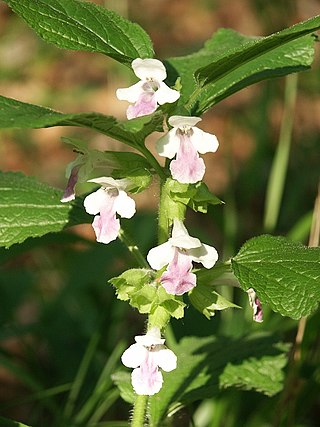
Melittis melissophyllum is a species of flowering plant in the mint family, Lamiaceae. Its common name is bastard balm. It is the only species in the monotypic genus Melittis. The genus name is derived from the Greek melitta, which is in turn from melissa.

Dactylorhiza maculata, known as the heath spotted-orchid or moorland spotted orchid, is an herbaceous perennial plant of the family Orchidaceae. It is widespread in mountainous regions across much of Europe from Portugal and Iceland east to Russia. It is also found in Algeria, Morocco, and western Siberia.

Sesuvium portulacastrum is a sprawling perennial herb in the family Aizoaceae that grows in coastal and mangrove areas throughout much of the world. It grows in sandy clay, coastal limestone and sandstone, tidal flats and salt marshes, throughout much of the world. It is native to Africa, Asia, Australia, Hawai`i, North America and South America, and has naturalised in many places where it is not indigenous.

Juncus acutus, the spiny rush, sharp rush or sharp-pointed rush, is a flowering plant in the monocot family Juncaceae. It is native to the Americas, Northern and Southern Africa, Western and Southern Europe and West Asia, and is found in a variety of wet habitats, such as bogs, fens, meadows, and salt marshes, and along the edges of ponds and lakes.

Arctium tomentosum, commonly known as the woolly burdock or downy burdock, is a species of burdock belonging to the family Asteraceae. The species was described by Philip Miller in 1768.

Dactylorhiza sambucina, the elder-flowered orchid, is an herbaceous plant belonging to the family Orchidaceae. It is quite common and widespread throughout much of Europe from Portugal east to Finland and Ukraine. The flowers appear in spring and summer, in various colors from yellow to purple.

Pentanema is a genus of Asian and African plants in the tribe Inuleae within the family Asteraceae.
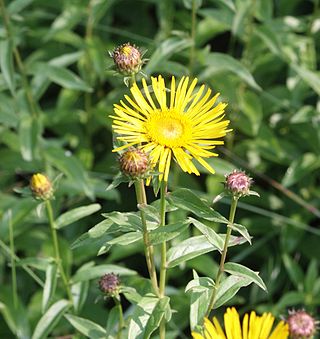
Pentanema salicinum is a plant species in the family Asteraceae. It is found across Eurasia from Portugal to Japan. It has been reported growing in the wild in a few scattered locations in North America but it has not become widely established there.
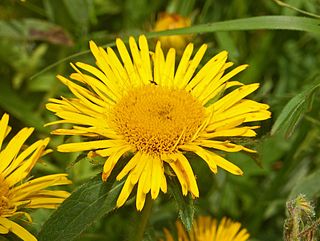
Pentanema hirtum is a species of perennial herbaceous plant belonging to the family Asteraceae. The specific Latin name hirtum refers to the type of hairiness of the plant.

Aegonychon purpurocaeruleum, commonly known as the purple gromwell, is a herbaceous perennial rhizomatous flowering plant and it belongs to the family Boraginaceae.

Pentanema squarrosum, known as ploughman's-spikenard, is a species of plant in the family Asteraceae found in Europe, North Africa, and the Near East.
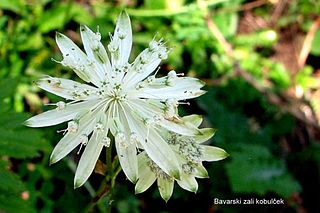
Astrantia bavarica, common name masterwort, is a species of flowering plant in the family Apiaceae, native to Eastern alps. Growing to 30 cm (12 in) tall by 30 cm (12 in) broad, it is an herbaceous perennial, much used in gardens.




















